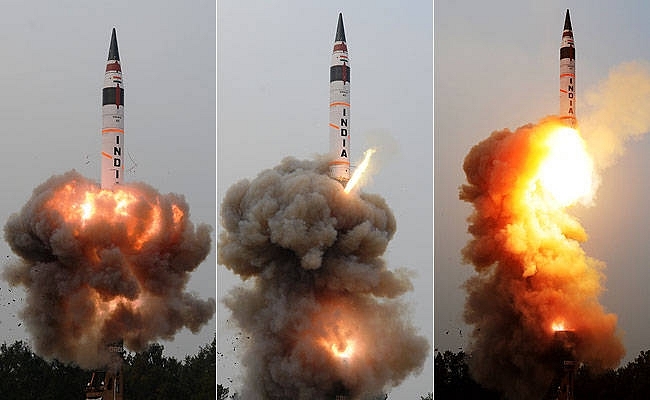
Destination Beijing: Why The Agni-V Is A Game Changer For India
It was not for nothing that the test of Agni-V in 2016 forced China to turn to an 18-year-old United Nations Security Council resolution to condemn India’s move. China was rattled. India had credibly demonstrated its ability to target important Chinese cities, and Beijing was quick to identify the implications of this tectonic change in New Delhi’s capability through its belligerent rhetoric.
However, back then, the development of the missile was far from complete. Five years down the line, despite five successful tests, the missile may still be some time away from being inducted into the Strategic Forces Command (SFC) and produced in numbers, but today’s test was crucial. It was the missile’s first user trials, a step forward toward its eventual induction into the SFC.
Once inducted, the Agni-V will prove to be a game changer in four ways:
One, the long range of the Agni-V, reported to be around 5,000 kilometres, enables India to bring all important Chinese cities, including Beijing, under threat. With this missile inducted, India can make sure that it responds to a Chinese nuclear attack with massive retaliation, as laid-out in the country’s nuclear doctrine. Thus, the missile will play an important role in establishing the credibility of deterrence viz-à-viz China.
Two, Agni-V is a solid-fueled missile. Solid-fueled missiles offer the benefit of a quick response and longer storage life. Prearranging a liquid-fueled missile for launch, in comparison, takes more time. Also, in case of non-use, liquid fuel must be drained out from the missile due to its highly corrosive nature and stored separately. Therefore, it is easy to store and transport a solid-fueled missile.
This also gives India the option to canisterise the missile. While the first two launches of the Agni-V – on 19 April 2012 and 15 September 2013 respectively – were of the standard Indian uncanisterised missile, following the patter set with the Agni variants I through IV, the last two tests conducted in 2015 and 2016 were of a canisterised system. In this configuration, a missile mated with a nuclear warhead is sealed in a canister, which is placed atop a road-mobile launcher.
Canisterisation enables a missile to be kept in a state of readiness, makes camouflaging the missile easier and permits rapid launch. Being placed on a road-mobile launcher, the missile can be moved from one location to another in times of heightened conflict to avoid detection by enemy satellites.
In this age of space based surface scanning radar, India has opted for deception coupled with mobility to prevent its road-mobile intercontinental ballistic missiles from being located easily. In the past decade, India has found rail-mobile configurations of the Agni-II and Agni-III somewhat complex to operate and is now moving towards canisterised road-mobile systems like the Agni-V. Having Agni-V on a mobile launcher will also help India maintain a second-strike capability, that is the ability to strike with a nuclear weapon even after facing a nuclear strike.
Three, India, for long, has chosen to keep its missiles and nuclear warheads unmated to avoid accidents. However, this is set to change with Agni-V. In the canisterised configuration, the missiles are required to be mated with nuclear warheads before being loaded onto mobile launchers. Other missiles in the Agni series, Agni-I through IV, are not encapsulated in a canister. While nuclear warheads in case of these missiles can be mated and de-mated whenever required, Agni-V will not have that option. This marks an important change in India’s nuclear deployment strategy.
India’s deployment of Submarine-Launched Ballistic Missiles (SLBM), called the K-series, to arm it’s fleet of nuclear submarines, also reflects this change. As part of the K-series, the Defence Research and Development Organisation has developed K-15 (also called B-05) missile with a range of 750-km. While the K-15 has entered series production, the next missile in the series – K-4 – is in the trial phase. The fourth test of the K-4, which has a range of around 3,500 km, is expected soon. This will be followed by tests of K-5 missile, a 5,000 km SLBM. All SLBMs are mated with warheads before being placed in submarines.
Four, the development of Agni-V has buttressed India’s capability to develop and operationalise Anti-Satellite (ASAT) weapons. Although India is against the weaponisation of space, China has been moving in this direction for at least a decade and has reportedly tested its capability too. If its assets in the space are threatened, India can quickly develop ASATs in response.
Former DRDO Chief, Dr Saraswat, had in 2012 admitted that the Agni-V had “ushered in fantastic opportunities in, say building Anti-Satellite (ASAT) weapons and launching mini/micro satellites on demand”.
"An ASAT weapon would require to reach about 800km altitude... Agni V gives you the boosting capability and the 'kill vehicle', with advanced seekers, will be able to home into the target satellite,'' he had noted back then.